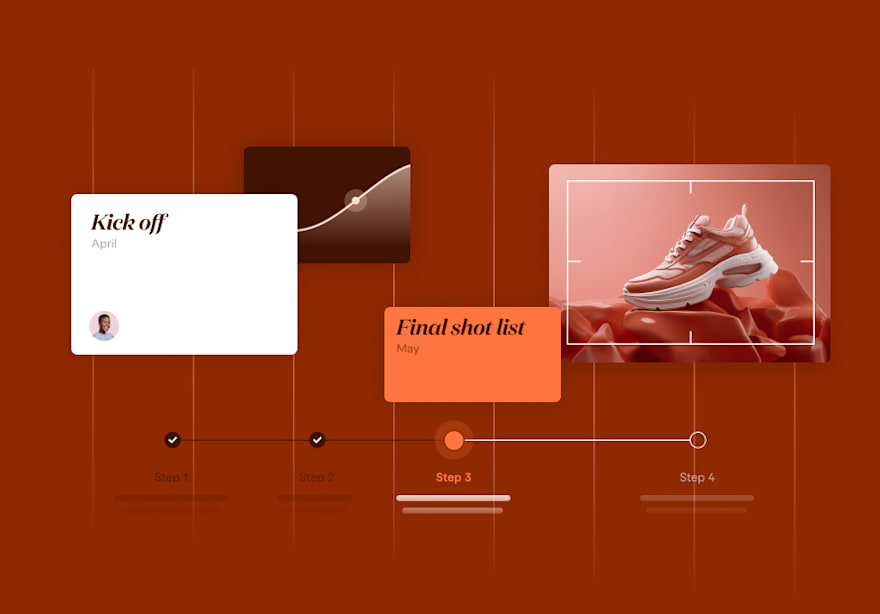How To Make a Successful Promo Video
Creating promo videos is a strategy for helping you build brand awareness, drive sales, and increase customer engagement.
 December 24, 2024
December 24, 2024 8 minute reading
8 minute reading
A compelling promo video isn’t a market luxury anymore. It’s a must-have tool if you want to stand out in your industry.
Many businesses hesitate to invest in online video marketing, thinking it requires an expensive agency to be successful. But the opposite is true. It’s possible to produce an outstanding promo video using various inexpensive tools and freelancers.
Whether you're a startup looking to make your first splash or an established company ready to refresh your image, this guide will teach you how to craft videos that captivate your audience.
Why you should use promo videos
Creating promotional videos for your brand is a good idea for several reasons, including the following three:
They build brand awareness
The primary purpose of a promotional video is to promote your product or services to your target audience, which helps you build brand awareness. Data from Wyzowl's 2024 video marketing survey supports this idea. In the report, 90% of video marketers say video has helped them increase brand awareness.
Some types of videos that help increase brand awareness include social media video marketing, presentation videos, and tutorials.
They drive sales
87% of video marketers said video has directly increased sales for their respective brands. Promotional videos work so well to help drive sales because good promo videos give context to the product or service. This context is crucial, especially for brands primarily operating online, like ecommerce stores or professional services.
Some promotional videos that drive sales and conversions include testimonial videos, product demo videos, and explainer videos. From a paid marketing perspective, video ads work well to drive sales, as do user-generated content (UGC) videos.
They increase customer engagement
When you create video content for your target market, there's a good chance you'll increase consumer engagement. According to a 2023 study in the Internet Research Journal, short branded videos that are relevant, tell a story, and generate emotions create positive engagement (ex. likes, comments, and shares).
Some promotional video ideas that can help with this goal include explainer videos, product videos, and entertainment videos.
What's included in a good promo video?
In a perfect world for brands, every promotional video would be successful. However, that's not the reality. There are a few factors that help determine the success of a promo video. Here are some of the main ones.
An attention-grabbing hook
If you've spent any time on TikTok, Instagram Reels, or YouTube Shorts, you'll probably notice that videos you stick around to watch grabbed your attention within the first five seconds or so.
Take the video from Thomas Summers, for example.
Within the first five seconds, the creator asks the viewer, "Question for you, is back squatting overrated?"
For his target audience, amateur and pro athletes, this is a pretty controversial question, given the popularity of back squats. As a result, the question serves as a hook that encourages viewers to watch the rest of the video.
Find Video Promotion Experts
Short video length
Within the last five to six years, says Gloria Mark (PhD), the average viewers' attention spans have reduced from around 75 seconds to just 47 seconds. This point is backed up by 39% of marketers saying 30–60 seconds is the most effective length for video marketing content.
In this TikTok, author Samantha Shannon creates a teaser of one of her recent book releases with a trendy song to accompany the visuals. The video is only ten seconds long and (at the time of writing) has 199k likes, 325 comments, and almost a thousand saves. It's not bad for an account with 53k followers.
Captions
If your video includes any kind of speech, having captions is crucial. First, captions help improve the accessibility of your content for those with hearing difficulties. Second, over half of people aged 45 and below use captions or subtitles while watching video content "some or all of the time."
Simply put, if your videos do not have captions, you risk viewers tuning out because they're having trouble understanding the content.
A clear call-to-action (CTA)
The last factor is having a clear CTA at the end of the video or within the video description. The point of a promo video is to promote a product or service, after all. You will want your viewers to take some kind of action after seeing it.
In this short TikTok, user Gohar Khan shows us some Japanese stationery. At the end of the video, he uses some products to write an in-video CTA of "follow for study tips!" The CTA is simple and tells viewers exactly what action he wants them to take.
How to create a promo video
Okay, so you're convinced you need to make a promo video for your business. Where do you start? In this section, we'll give you a detailed step-by-step approach to producing a top-notch promo video.
1. Plan your video
Planning your promo video involves completing a couple of subtasks, which include:
Defining the goal of your video
Defining your target market
You might have an idea for a promo video already in mind, but before you start putting it together, make sure you know what you're trying to achieve. The reason? Different goals require different approaches and methods of measuring success.
For example, if you're looking to generate more leads for your business, you'll want your video to focus on solving their problem. On the other hand, if you want to build more brand engagement, you'll want your video to create curiosity and conversation.
With your goal in mind, you'll be much better equipped to know who your target audience for the video is. However, if you're stuck with defining your audience accurately, consider the following demographic and psychographic factors:
Age
Location
Gender
Occupation
Income level
Personality
Attitudes
Values
Interests/hobbies
Lifestyles
Behavior
Then, with those factors in mind, ask the following questions:
What are their pain points?
How does your product or service fit into their lifestyle?
How and when will they use your product or service?
What can they learn from your video?
What type of content do they want to see?
Where do they most often watch videos?
When you have a more complete picture of your target audience, it's easier to create content for them.
2. Build a storyboard
Your storyboard is an arrangement of your video’s vision, ideas, and sequence. Its purpose is to bring your ideas to life visually, as well as help you build out some of the practical elements of your ideas.
A storyboard will help you define the visual content of your video, including product placement, the people or characters in the video, the location, and the camera angles and maneuvers (otherwise known as the shot list).
3. Create a video script
A good video script is an essential component of a promotional video. The words need to help your video achieve its goals most effectively. If the dialogue falls flat, you risk spending a lot of resources for very little return on your investment.
If you have trouble with writing your video scripts, you can always find video script writing services to give you the expert touch before moving into video production.
4. Produce the video
The next step is to bring your plans to life. The practicalities of this step depend on whether you're producing a live-action video or an animated video.
For live-action videos, you'll want to have decent-quality recording equipment. As a quick list, this should include a camera, microphone, and lighting.
If you don't have access to recording equipment yourself, you can either rent it, or hire a freelancer who works in filmed video production to shoot the video for you.
On the other hand, if you're producing an animated video, there are fewer external factors to worry about (like weather and actor availability). However, creating an animated promo video yourself can be a big learning curve, so we'd suggest finding expert animation services.
5. Edit the video
After you've recorded (or animated) all the footage you need for your promo video, you need to edit it. Editing the footage gives it clarity and continuity and improves the overall quality of the video. Use layers of audio, like music and voice overs, and other visual elements, such as transitions or animated text overlays.
To edit your footage, you'll need to use video editing software. Some software options are designed with beginners in mind, while others are made for professional video producers.
Some of the best software options include Descript (beginner-friendly), CapCut (TikTok integration), and DaVinci Resolve 19 (a more advanced but excellent free option).
On the other hand, if mastering video editing tools isn't a task you enjoy or have time for, you can find video editing services to help you make your promo video shine.
6. Promote your video
The final step to improving your chances of creating a successful promotional video is promoting it effectively. Simply posting the video and waiting for your audience to stumble upon it is not enough.
One tactic you can use to promote your video is by sharing it across your marketing channels. To do so, prepare your video by:
Optimizing the titles, descriptions, and other components for SEO purposes
Adding captions to your social media videos so viewers don’t have to rely on sound to understand your video
Optimizing the video’s size for each social platform you want to share it on, as each platform has different optimal size requirements
Saving the video’s embed code (which you can obtain from platforms like YouTube and Vimeo) to embed in a blog post or email marketing sequence.
Otherwise, you can hire a freelancer to help you with video promotion and distribution.
DIY versus professional help
If you think about it, producing top-quality videos often requires a team of people (have you ever sat through the end credits of a movie?) So, it's rare for one person to have all the skills needed to make great promo videos.
Even so, you might have some experience producing video content and feel like you can go ahead and DIY the process. However, you might find that the end product isn't as good as you would like it to be, or you find yourself settling on "that'll do."
When you come across these moments, it's a good idea to consider whether hiring a professional to do the work is worth it. The answer to this question depends on two things: your resources and goals.
Hiring professionals makes sense when you aim to create top-quality content and are low on knowledge/skills and time. For example, if producing video content isn’t something you want to spend time learning, you can delegate it to professionals and focus your energy on other aspects of your business.
On the other hand, DIY is a good approach if you think creating video content is where you want to spend a lot of time and enjoy the whole process.
Difference in cost
You can think of cost from two different perspectives: the financial cost and the opportunity cost.
In terms of financial cost, if you already have good-quality recording equipment, the cost of DIY-ing your videos is relatively minimal. However, if you don't have equipment, expect to spend a few hundred or even thousands of dollars on appropriate recording equipment and editing software.
You might also be thinking about using an AI video generator to bridge the gap between your skills and equipment and your idea. Some of the most popular apps for AI video generation include:
Synthesia (for AI avatars)
InVideo (for faceless videos)
Runway (for advanced AI-powered, high-quality videos)
The issue with using these tools is that they can also be pretty expensive if you do not want free-plan limits, and they also have a learning curve to master.
On the other hand, hiring an expert video editor can be a fraction of the cost of investing in equipment or using an AI video generator.
Opportunity cost refers to the potential revenue your brand could miss out on by producing a low-quality promotional video yourself, instead of hiring it out. While saving money on production might seem appealing, a poorly made video could take too much time and also fail to attract as many customers. This could lead to lost sales and a lower return on investment (ROI) compared to a higher-quality video that could better engage your audience and drive results.
Hire your video team on Fiverr
With all the above in mind, of course, it's possible to DIY your promo videos. With a decent up-front investment in time and money, you can produce fantastic quality videos.
But if you need to produce great videos sooner rather than later, or if creating the content is not where you want to spend your time, hiring a video team on Fiverr is a good option.
With experts in online video marketing, script writing, live video production, animation, and editing, you only need to bring an idea. With your idea, a team of video experts from Fiverr can help you bring it to life.
Promo video FAQs
How do I make a promo video?
Making a promo video involves six steps:
Plan your video
Build a storyboard
Create a video script
Film the video
Edit the video
Promote the video
What is the best free promo video maker?
If you need a quick, free video maker that doesn't involve any new filming, Canva is an excellent option with an extensive library of video templates. However, if you want to edit video clips you've filmed, Descript is a better, beginner-friendly option for making promotional videos.
How to create a promotional video using AI?
You can use AI to help you with several steps along the video production process. Some programs, like Runway, help you generate videos from text or image-based prompts.
However, it's more common (and cheaper) to use AI to help you edit the video you've shot yourself. Software such as Descript can help you edit videos for clarity, repurpose them for various platforms, and create highlight reels. If you don’t want to use AI, you can have a professional from Fiverr do a video consultation review.
How do you film a promotional video?
To film a promotional video, you'll need to:
Understand your audience
Write a great script
Plan your shots
Have or hire the right equipment
Choose an appropriate location
Direct with confidence, especially if you decide to work with actors



